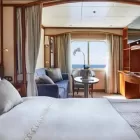- Ship
- 1 Breakfast, 1 Lunch, 1 Dinner
Three kilometers off Yukon’s north coast, only Workboat Passage separates Herschel Island-Qikiqtaruk from Ivvavik National Park. The low-lying, treeless island of 116 square kilometers was Yukon’s first territorial park. Herschel Island-Qikiqtaruk was declared a National Historic Site of Canada in 1972, classified as a Nature Preserve in 1987, and designated a Natural Environment Park in 2002. As an example of the technologies and techniques used for living and construction over the past several millennia, it is now on the tentative UNESCO WHS list! The island is also an important area for Ice Age fossils. Normally snow-covered from September to June, the island shows abundant and diverse wildlife, with many migratory birds, including the largest colony of Black Guillemots in the Western Arctic, caribou, muskox, polar bear, and brown bear on land, bowhead and beluga whales, ringed and bearded seals, and occasionally walrus in its surrounding waters. Seasonal hunting possibilities from spring to fall have led the Inuvialuit to use the area for hundreds of years. When Franklin arrived in 1826, he saw three of their camps. The remains of their old dwellings are still visible near Simpson Point. This is where, in the late 1800s, American whalers established a now-abandoned station. At the height of the Beaufort Sea whale hunting period, there were 1,500 residents. Several of the historic buildings built by whalers and later missionaries, traders, and the RCMP are still standing, although some had to be moved further inland to escape the rising sea level.



























